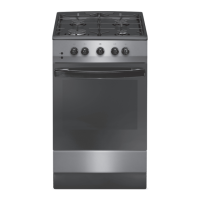14
Adjusting the Temperature
After you ignite the oven burner as explained before, you can adjust the temperature inside the oven as you
require, using the numbers on the control: Larger numbers mean higher temperatures, while smaller numbers
mean lower temperatures. Refer to the temperature table on the “Cooking” section for the approximate
temperature references of those numbers. Do not operate the appliance between the OFF “ ” position and the rst
temperature marker in the counter-clockwise direction. Always use the oven between the maximum and
the minimum numbers.
The temperature at the centre of the oven corresponds with the selected gas mark and is slightly higher towards
the top of the oven and slightly lower towards the bottom of the oven.
Preheating
When you need to preheat the oven, we recommend you do so for 10 minutes. For recipes needing high
temperatures, e.g. bread, pastries, scones, soués etc., best results are achieved if the oven is preheated rst.
For best results when cooking frozen or cooked chilled ready meals always preheat the oven rst, unless the
cooking instructions advise you otherwise.
Cooking
• Ensure that food is placed centrally on the shelf and that there is sucient room around the baking tray/dish to
allow for maximum heat circulation.
• Stand dishes on a suitably sized baking tray on the shelf to prevent spillage onto the oven base and to help
reduce cleaning.
• The material and nish of the baking tray and dishes used aect browning of the bottom of the food. Enamel-
ware, dark, heavy or non-stick utensils increase browning of the bottom of the food. Shiny aluminium or
polished steel trays reect the heat away and give less browning of the bottom of the food.
• When cooking more than one dish in the oven, place dishes centrally on dierent shelves rather than cluster
several dishes on one shelf, this will allow the heat to circulate freely for the best cooking results.
• If you are cooking more than one tray of similar items, for example cakes or biscuits, swap the trays during
cooking or you can remove the top tray when the food is cooked and move the lower tray to the higher shelf to
nish cooking.
• The thermostat settings detailed below are a guide only and refer to the approximate temperature in the centre
of the oven.
Oven setting 1 2 3 4 5 6 7 8 9 10
Temperature in °C 136 137 154 165 174 185 190 203 215 237
• If accurate temperatures are required then this should be checked using an oven thermometer available at
most cookware shops.
• Do not place baking trays or any covering for example aluminium foil directly on the oven base. It interferes
with the oven air circulation and can lead to burning of the food, or damage the oven cavity. Use the lower shelf
position.
• During cooking, do not open the door unnecessarily as you will lose heat and your cooking results may change.
Cooking times will be longer and energy use will be higher.
• Using cake tins when cooking cakes will give better results.
• During use, the outer and inner surfaces of the oven get hot. While opening the oven door,
step back to avoid the hot steam coming out of the oven. There may be a risk of burns.
• Always use oven gloves to remove and replace food in the oven.

